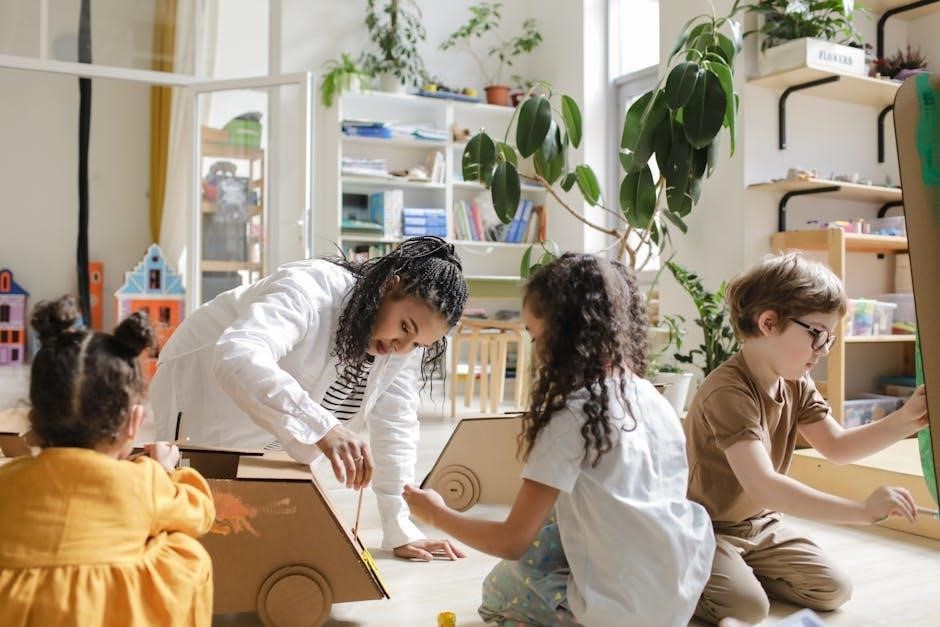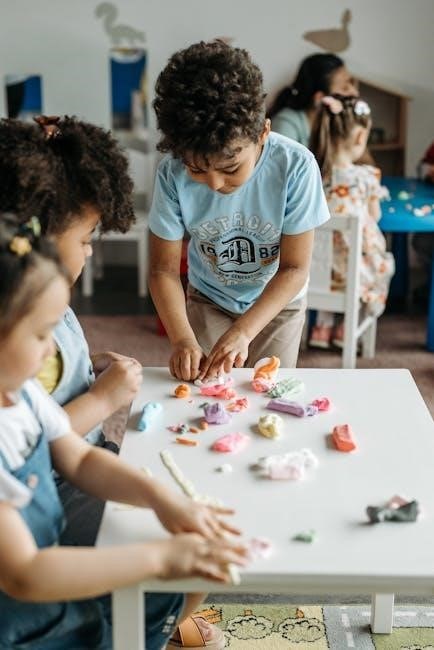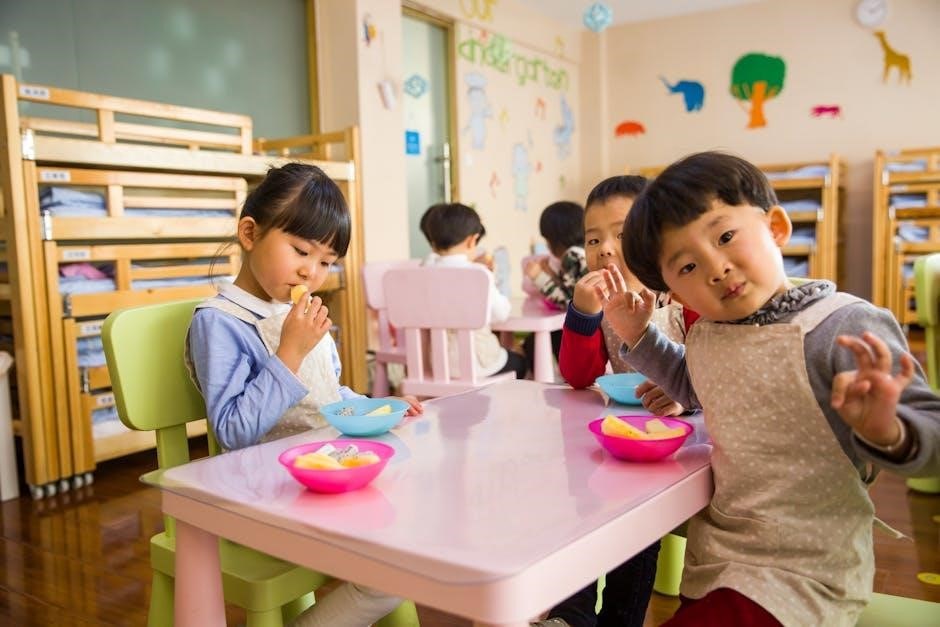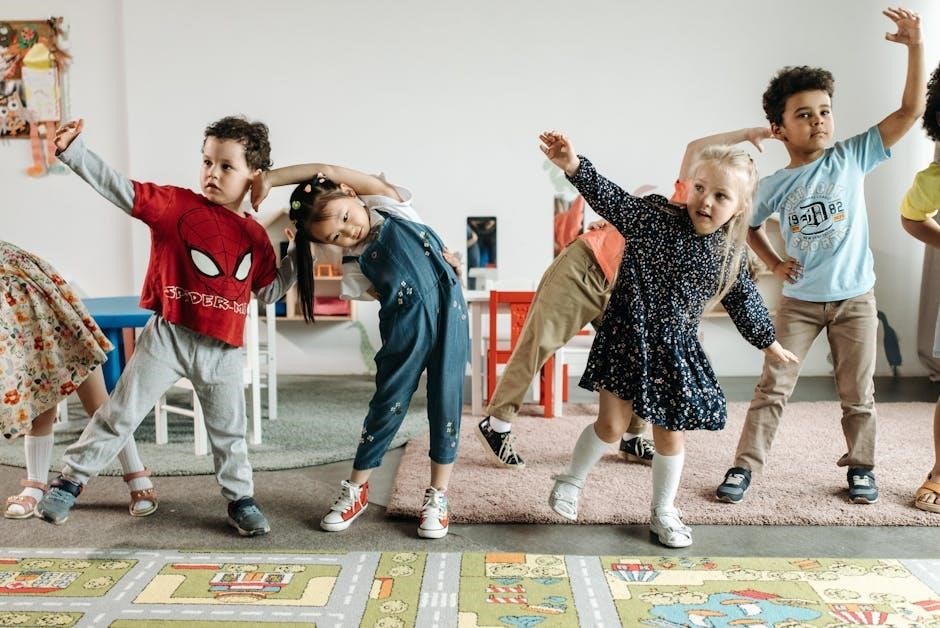
Effective preschool classroom management is the foundation for creating a positive learning environment․ It ensures consistency, promotes social-emotional growth, and supports young children’s academic development through structured routines and clear expectations․
1․1 The Importance of Effective Classroom Management in Preschool
Effective classroom management in preschool is essential for fostering a supportive and engaging learning environment․ It helps young children develop social-emotional skills, build self-discipline, and establish positive relationships with peers and teachers․ By creating a structured and predictable setting, teachers can minimize disruptions, encourage active participation, and ensure that all children have opportunities to thrive academically and socially․ A well-managed classroom also reduces stress for both teachers and students, promoting a culture of respect and collaboration․
1․2 Key Goals of Preschool Classroom Management
The key goals of preschool classroom management include establishing a structured environment, fostering independence, and encouraging positive interactions among children․ These goals help teachers create engaging activities, promote smooth transitions, and minimize disruptions․ By setting clear expectations and using consistent strategies, educators can support children’s social-emotional development while ensuring a productive learning atmosphere․ Effective classroom management also involves using data collection tools to track progress and address challenging behaviors proactively, ensuring a balanced approach to academic and social growth․
Establishing Clear Expectations and Routines
Clear expectations and routines provide a structured environment, fostering consistency and positive behavior․ Visual schedules and predictable rituals help children transition smoothly and reduce anxiety․
2․1 Creating a Positive Classroom Environment
Creating a positive classroom environment involves designing a child-friendly space that fosters engagement and reduces disruptions․ A well-organized layout with accessible materials and safety considerations encourages independence․ Incorporating visual schedules and calming colors helps students feel secure․ Positive reinforcement, such as praise, strengthens self-esteem․ Building a sense of community through collaborative areas and inclusive practices promotes social connections․ This supportive atmosphere lays the groundwork for effective learning and behavior management in preschool settings․
2․2 Setting Behavioral Expectations for Young Children
Setting clear behavioral expectations helps young children understand what is expected of them, fostering a structured and predictable environment․ Simple, age-appropriate rules, such as raising hands to speak or using kind words, guide their actions․ Consistently communicating these expectations using visual reminders or role-playing ensures clarity․ Positive reinforcement, like praise, encourages good behavior, while gentle redirection corrects missteps․ Clear expectations promote self-regulation, respect, and a cooperative classroom atmosphere, essential for social and academic growth․
2․3 The Role of Visual Schedules and Routines
Visual schedules and routines play a crucial role in preschool classroom management by providing structure and predictability․ They help young children understand transitions and expectations, reducing anxiety and behavioral challenges․ Using visual aids like charts or timers ensures consistency, allowing children to anticipate activities and develop self-regulation skills․ This approach fosters independence, as children can follow routines with minimal adult intervention, creating a smooth and organized learning environment․
Positive Reinforcement Strategies
Positive reinforcement strategies foster a supportive classroom environment by encouraging desired behaviors through praise, encouragement, and reward systems, promoting self-confidence and social-emotional growth in young children․
3․1 Using Praise and Encouragement Effectively
Using praise and encouragement effectively fosters a positive classroom environment, boosting children’s confidence and self-esteem․ Specific, genuine compliments highlight their efforts and achievements, encouraging repetition of desired behaviors․ For example, saying, “I really like how you shared the toy,” acknowledges kindness and promotes social-emotional growth․ Consistent, sincere encouragement helps preschoolers develop resilience and a growth mindset, motivating them to explore and learn without fear of failure․ This approach strengthens teacher-student relationships and creates a supportive atmosphere for overall development․
- Focus on effort, not just outcomes․
- Be specific to reinforce desired behaviors․
- Use verbal and non-verbal cues consistently․
3;2 Implementing Reward Systems for Preschoolers
Reward systems are an effective way to encourage positive behavior in preschoolers․ Stickers, stars, or verbal praise can motivate children to follow classroom rules․ These systems help young learners understand the connection between their actions and consequences․ Consistent use of rewards fosters a sense of accomplishment and responsibility․ It also teaches social-emotional skills like sharing, cooperation, and self-control, creating a supportive and engaging learning environment․
3․3 Teaching Social-Emotional Skills Through Positive Reinforcement
Positive reinforcement is a powerful tool for fostering social-emotional skills in preschoolers․ By acknowledging and rewarding positive behaviors, teachers encourage empathy, self-control, and cooperation․ Techniques like praise, encouragement, and non-verbal cues (e․g․, stickers or stars) help children develop self-awareness and responsibility․ This approach not only reinforces desired behaviors but also fosters a supportive classroom culture, enabling young learners to navigate social interactions and emotional challenges with confidence and resilience․

Organizing the Preschool Classroom Environment
A well-organized preschool classroom environment enhances learning and behavior․ Arranged with accessibility in mind, it supports exploration and engagement, creating a safe and structured space for young learners․
4․1 Designing a Child-Friendly Classroom Layout
A well-designed classroom layout fosters engagement and independence․ Organize spaces into activity zones, such as art, reading, and play areas, to promote exploration․ Ensure furniture is child-sized and accessible, with storage bins labeled for easy access․ Incorporate visual aids like charts and schedules to enhance understanding․ Safety is key, with materials within reach and sharp objects secured․ Natural light and cozy corners create a welcoming atmosphere, encouraging learning and social interaction among young children․
4․2 Using Educational Materials to Promote Engagement
Selecting age-appropriate educational materials is crucial for fostering engagement in preschoolers․ Hands-on activities, interactive toys, and visually appealing resources capture their attention and encourage active participation․ Organizing these materials in accessible areas allows children to explore independently, promoting curiosity and creativity․ Aligning materials with learning objectives ensures they are both entertaining and educational, supporting cognitive and social development effectively․
4․3 Managing Classroom Resources and Materials
Organizing classroom resources and materials is crucial for promoting efficiency and engagement․ Labeling storage areas and ensuring accessibility help children locate items independently․ Regular maintenance and rotation of materials keep activities fresh and interesting․ Involving children in cleanup teaches responsibility and fosters a sense of ownership․ Additionally, regularly checking materials for safety and functionality ensures a conducive learning environment, supporting both educational and creative activities effectively․

Addressing Challenging Behaviors
Addressing challenging behaviors requires understanding their root causes and implementing proactive strategies․ Techniques like redirection, positive reinforcement, and environmental adjustments help create a calm and respectful classroom atmosphere․
5․1 Identifying Common Misbehaviors in Preschoolers
Common misbehaviors in preschoolers often include hitting, shouting, refusal to share, and tantrums․ These actions stem from limited self-regulation skills and understanding of boundaries․ Recognizing these behaviors early helps teachers address them effectively․ For instance, hitting may indicate frustration, while not sharing might reflect possessiveness․ Understanding the root causes enables educators to implement appropriate strategies, fostering a supportive environment for social-emotional growth and positive interactions among young learners․
5․2 Strategies for Reducing Disruptions and Conflict
Strategies to minimize disruptions and conflicts in preschool classrooms include using visual reminders, encouraging open communication, and incorporating movement breaks․ Teaching conflict-resolution skills, such as sharing and taking turns, helps children manage disagreements․ Redirecting attention to engaging activities and using positive reinforcement for calm behavior can also reduce disruptions․ Creating a predictable routine and ensuring access to necessary materials fosters a respectful and focused learning environment․
5․3 Using Problem-Solving Techniques with Young Children
Problem-solving techniques empower young children to address conflicts and challenges constructively․ Encouraging critical thinking, teachers guide students to identify issues, brainstorm solutions, and reflect on outcomes․ Role-playing and group discussions foster collaboration, helping children develop empathy and decision-making skills․ These strategies reduce disruptions, promote self-regulation, and create a respectful classroom culture, equipping children with essential life skills for managing disagreements and understanding consequences․
Collaborating with Parents and the Community
Collaborating with parents and the community fosters a supportive learning environment․ Open communication, shared goals, and mutual involvement ensure consistency in classroom management and child development․
6․1 Communicating with Parents About Classroom Management
Effective communication with parents is crucial for aligning classroom management strategies at home and school․ Regular updates through newsletters, meetings, or digital platforms ensure transparency and involvement․ Parents should be informed about classroom rules, expectations, and positive reinforcement techniques to foster consistency․ Encouraging open dialogue helps address concerns and builds trust, creating a collaborative environment that supports the child’s development and behavior management․ This partnership enhances the child’s sense of security and promotes positive outcomes․
6․2 Involving Parents in Supporting Classroom Rules
Involving parents in supporting classroom rules fosters consistency between home and school environments․ Teachers can collaborate with parents through regular meetings or updates, ensuring they understand and reinforce classroom expectations․ Parents can encourage positive behavior by discussing rules at home and praising their child’s adherence․ This partnership strengthens the child’s sense of responsibility and helps build a cohesive support system․ Open communication and shared goals create a united front in promoting positive behavior and classroom harmony․
6․3 Building Partnerships with the Community for Classroom Support
Building partnerships with the community enhances preschool classroom management by providing additional resources and support․ Local organizations can offer educational materials, volunteer assistance, and funding for classroom activities․ Community involvement fosters a collaborative environment, enabling teachers to access workshops and training programs․ These partnerships not only enrich learning experiences but also strengthen ties between schools and local stakeholders, creating a network that benefits both educators and students․

Data Collection and Analysis
Using digital tools, educators can track behaviors, progress, and interactions, enabling data-driven decisions to refine management strategies and support individual student needs effectively․
7․1 Tracking Student Behavior and Progress
Tracking student behavior and progress is essential for understanding individual and group dynamics in a preschool classroom․ By using tools like behavior checklists, observation logs, and digital platforms, teachers can monitor children’s social-emotional development and academic growth․ This data helps identify patterns, address challenges early, and tailor strategies to meet each child’s needs․ Regular tracking also supports communication with parents and informs decision-making for improving classroom management practices․
7․2 Using Digital Tools for Classroom Management Data
Digital tools streamline data collection and analysis, enabling teachers to track student behavior, interactions, and progress efficiently․ Apps and software can record incidents, monitor positive interactions, and generate reports․ These tools provide insights into classroom dynamics, helping teachers identify trends and adjust strategies․ They also facilitate communication with parents and administrators, ensuring a collaborative approach to supporting student development and maintaining a well-managed learning environment․
7․3 Analyzing Data to Improve Management Strategies
Analyzing data is crucial for refining classroom management strategies․ By reviewing behavior trends, teachers can identify patterns and adjust approaches to better support students․ Digital tools simplify tracking behavioral progress and engagement, enabling informed decision-making․ Regular data analysis helps tailor interventions, ensuring strategies remain effective and responsive to student needs․ This iterative process fosters a dynamic, adaptive learning environment that promotes positive outcomes for all children․

Continuous Professional Development
Engaging in workshops, training, and reflective practices helps educators refine their classroom management skills, ensuring they stay updated on evidence-based strategies and innovative teaching methods․
8․1 Staying Updated on Best Practices in Classroom Management
Staying informed about the latest research and methodologies is crucial for effective classroom management․ Teachers can benefit from attending workshops, reading educational journals, and participating in professional development programs․ Resources like the study by Darling-Hammond and Morris provide insights into evidence-based practices․ Regularly updating knowledge ensures teachers can adapt strategies to meet the evolving needs of their students, fostering a supportive and engaging learning environment․
8․2 Participating in Workshops and Training Programs
Participating in workshops and training programs is crucial for preschool teachers to enhance their classroom management skills․ These programs provide evidence-based strategies, such as positive reinforcement techniques and conflict resolution methods, as highlighted in research by Darling-Hammond (2020) and Morris (2013)․ Through interactive sessions and hands-on activities, educators gain practical insights to create structured and supportive learning environments․ Additionally, these opportunities foster collaboration and networking among teachers, promoting the sharing of best practices and continuous improvement in teaching methodologies․
8․3 Reflecting on Teaching Practices for Improvement
Reflecting on teaching practices is essential for continuous improvement in preschool classroom management; By regularly reviewing strategies and their effectiveness, teachers can identify areas for growth and refine their approaches․ This reflection fosters a mindset of ongoing learning, ensuring that methods remain aligned with the needs of young students․ It also encourages adaptability and innovation, leading to more effective and engaging classroom environments that support child development and academic success․